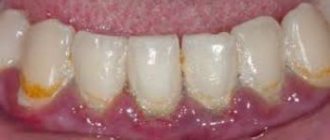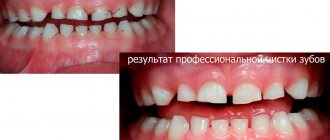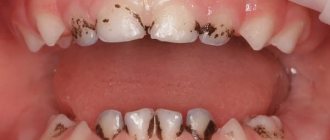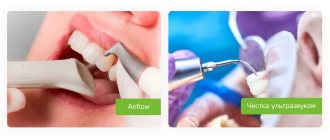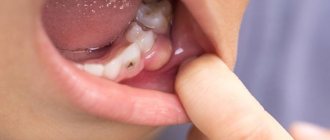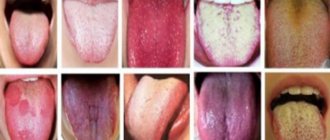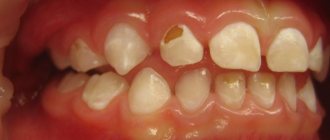Beautiful snow-white teeth are an important component of the image of a successful person. But for a number of reasons, the enamel becomes covered with an unaesthetic coating. This problem cannot be ignored, since soft plaque mineralizes and turns into tartar. It cannot be removed during normal oral hygiene. Deposits can only be removed by contacting the dentist.
If black plaque is not professionally removed , the patient will experience bad breath, darkening of the enamel, inflammation of the gums and the development of caries. As a result, he will have to treat the consequences that have arisen.
Why does plaque form on teeth?
Various factors can provoke the formation of plaque. It often consists of food debris, bacteria and is formed due to insufficient oral hygiene. But sometimes plaque appears even in those patients who regularly brush their teeth efficiently. Why? This is due to the darkening of the enamel under the influence of coloring pigments contained in coffee, strong black tea, and nicotine. In addition, a change in the aesthetic appearance of enamel is possible under the influence of certain medications, diseases of the liver, spleen, mouth rinses, as well as as a result of the activity of chromogenic bacteria (occurs in childhood).
Black plaque on teeth appears among workers in the metallurgical industry who daily inhale condensate containing microparticles of heavy metals. Units darken and collapse in people with drug addiction.
Reasons for appearance
- The first "popular" cause of dark teeth is smoking and the habit of drinking coloring drinks - coffee and tea - in large quantities.
- In addition to smokers and coffee drinkers, workers at metallurgical plants who inhale condensate mixed with heavy metals are at risk. When settling on the enamel, some of them create pigmentation.
- You can also recognize a patient with pathology of the spleen, liver or biliary tract by darkened tooth enamel.
- Long-term use of antibacterial drugs (antibiotics). The tetracycline group is especially dangerous in this case.
It is important to distinguish between bacterial origin and pathological pigmentation of the enamel. In the first case, we are talking about the fact that as a result of poor oral hygiene, the patient gives bacteria a chance to develop and multiply. A seemingly harmless, soft plaque becomes so dense already 10 hours after its formation that it is very difficult to remove it with a regular toothbrush and toothpaste. The color of the hardened lesion can vary from light yellow to dark gray, giving the visual appearance of “black teeth.”
Pigmented plaque on teeth is formed as a result of a combination of two factors - insufficient hygiene and the effect of pigments on tooth enamel - coffee, tea, nicotine. If the surface of the tooth is not perfectly clean and smooth, dark particles easily “stick” to it. Less “popular” reasons for darkening of teeth, but still worthy of mention, are rinsing the mouth with compositions with essential oils, chlorhexidine or benzalkonium chloride, loving foods rich in iron, and taking chewable vitamins with iron.
What to do?
Many people want to clean their teeth from plaque at home. To do this, they use special bleaching pastes, soda, activated carbon, 3% hydrogen peroxide solution, and lemon juice. Sometimes, with slight darkening of the enamel, these methods give the desired effect.
But if you abuse such bleaching, as well as in case of increased sensitivity of the enamel, you can only harm yourself. Therefore, if you want to return your teeth to a snow-white shade, you need to start with a visit to a specialist. The dentist will assess the condition of the enamel, identify diseases of the oral cavity (if any) and recommend the best option for cleaning teeth from plaque.
In a clinical setting, there are several ways to get rid of deposits. Let's consider them in as much detail as possible. This will allow you to go for a consultation with a “theoretical savvy” specialist.
What is the prevention of plaque formation?
The first step is to completely abandon the harmful habit of smoking and frequent consumption of drinks that form black plaque on the teeth. It is imperative to diversify your diet with solid foods and fiber-rich vegetables, fruits, and cereals. Chewing such food thoroughly helps to naturally cleanse tooth enamel. Timely and properly organized hygienic care of the oral cavity is the basis for preventing the occurrence of plaque on teeth. In addition, do not forget to visit the dentist regularly, even if nothing bothers you.
So, as soon as a specialist can assess the state of plaque and notice problems with teeth in the initial and curable stage. Dental treatment and care requires regularity, strict adherence to specialist recommendations and a professional approach.
Professional Air Flow cleaning
This method is considered the most gentle on enamel and painless. The essence of the procedure is to influence deposits with a mixture of water, air and soda crystals, which is supplied under pressure. This way you can clean your teeth and the spaces between them.
The dentist recommends Air Flow cleaning to the patient in the following cases:
- the presence of plaque that turns into stone;
- discoloration of enamel caused by drinking strong tea, coffee, carbonated drinks, smoking;
- if it is necessary to install or remove crowns, braces, implants, high-quality cleaning of these systems;
- the presence of tightly spaced, twisted teeth in a row;
- the appearance of symptoms of periodontal disease.
Timely cleaning with such a device helps prevent the development of caries, gingivitis, periodontitis and periodontal disease. It allows you to effectively remove deposits on teeth, between units, even in the most inaccessible places, as well as on dental structures. At the same time, the enamel becomes lighter by 1-2 tones, pigment spots disappear. During polishing, the enamel is saturated with fluoride and strengthened.
Despite all the advantages of Air Flow, this procedure has a number of contraindications. In particular, it is not carried out when:
- severe pathologies of the respiratory system, including bronchial asthma;
- hepatitis;
- diabetes mellitus;
- tuberculosis;
- tendency to allergic reactions;
- HIV;
- infectious diseases;
- heart rhythm disturbances, presence of a pacemaker;
- increased sensitivity of enamel;
- the presence of areas of demineralization;
- installed titanium implants.
This method of professional cleaning is not recommended during pregnancy and lactation.
After the procedure, for 2-3 days the patient may complain of pain when eating cold and hot food. To reduce enamel sensitivity, you must use toothpaste labeled “Sensitive.” Be sure to buy a new brush with soft bristles.
During this period, it is better to exclude sour and sweet foods, cold and hot foods from the diet, refuse to drink carbonated drinks with dyes (including low-alcohol ones), coffee, strong black tea, and red wine. It is undesirable to eat red and orange fruits and vegetables.
Abuse of chlorhexidine-based mouthwashes
Teeth inevitably become covered with black plaque if you rinse your mouth with Chlorhexidine or rinses that contain this medicinal substance for a long time. Chlorhexidine fights bacteria and viruses well, helps eliminate the inflammatory process in the mucous membrane, helps damaged tissues recover faster, reduces bleeding gums, but it cannot be used for longer than 10–14 days in a row.
The enamel can also darken due to the abuse of rinses that contain benzalkonium chloride, as well as essential oils. Products with such components are not suitable for daily use. They are used only in courses and according to indications, for example, in complex therapy for the treatment of gingivitis or periodontitis.
Ultrasonic cleaning with the “Vector” device
The German “Vector” system was created specifically to rid teeth of plaque. It effectively removes soft and hard mineralized deposits on the coronal part of units, as well as in periodontal pockets. The peculiarity of the procedure is the use of a special nozzle; ultrasound is applied strictly vertically (top to bottom and bottom to top). This allows you to remove deposits carefully, comfortably and painlessly. The entire process is controlled and predictable; during the procedure, the dentist adjusts the amplitude of the waves.
Thanks to the use of a special solution with hydroxyapatite granules, high-quality polishing of the surface of the crown and root occurs; after such cleaning, the appearance of new plaque occurs several times slower. In addition, the liquid promotes rapid regeneration of inflamed tissues, reduces sensitivity during the procedure and makes breathing fresh.
Plaque removal using the Vector device can be carried out when:
- gingivitis;
- periodontitis;
- identifying periodontal pockets 4-6 mm deep;
- increased sensitivity of teeth and gums;
- atrophic processes, exposure of the necks of units.
The procedure is contraindicated in childhood, during pregnancy and lactation, in the case of deep periodontal pockets filled with pus. Also, cleaning is not carried out if there is severe mobility of the units, the presence of malignant tumors in the body, severe heart disease, or if there is a pacemaker.
After the procedure, the doctor recommends using a new soft brush and toothpaste for sensitive teeth. In addition, you should give up coloring foods and drinks and smoking for 2-3 days.
Multiple caries
Caries is not plaque, but a dental disease. However, it is precisely when the teeth become black. It should be noted that in the early stages of development, white or yellowish spots appear on the enamel, but they become black only as the tooth decays and the disease progresses.
Black color can also indicate the presence of tooth decay
A tooth can turn black due to injury and death of the pulp, or if it is depulped. In this case, the problem of smile aesthetics, depending on the clinical picture, can be solved by intracanal whitening, installation of veneers or crowns.
“Bottle” caries is common in children, in which the teeth, especially the front ones, become very black. If you do not want to face this problem, then do not give your baby sweet mixtures and juices at night.
“My tooth, on which there was a filling, turned black, it turned black right along the edge. I didn’t pay attention to it for a long time, because it was chewy—the blackness was not visible. I went to the doctor only when pain appeared. It turned out that the filling had moved away from the walls of the tooth and began to fit loosely, which I did not notice. Bacteria penetrated there and gradually repeated caries formed ... "
Larisa N., review from woman.ru
Laser cleaning
This is an innovative, gentle and painless method of cleaning teeth from plaque of any color (black, yellow, etc.). During the procedure, the enamel is not damaged, and there is virtually no gum bleeding. Although this method of dealing with deposits is expensive, the investment is completely justified.
Benefits of laser teeth cleaning:
- removal of plaque and tartar, regardless of location;
- low level of pain, and therefore local anesthesia is not required;
- the ability to regulate the intensity of the impact;
- absence of noise and vibration, which is important for patients with dental phobia;
- non-contact - the device does not come into contact with tissues;
- safety of the procedure - the formation of enamel microcracks is excluded;
- no gum bleeding - even if tissue is damaged, the blood immediately coagulates under the influence of the laser;
- minimal risk of complications - the beam has a disinfecting effect, so during the procedure all pathogenic microorganisms are killed;
- rapid tissue restoration - due to stimulation of trophism and reparative processes;
- lightening the enamel by 1-3 tones;
- long-term effect - no plaque on the teeth for a year, provided proper care of the teeth and the oral cavity.
Laser deposit removal can only be performed by adults (over 18 years of age). It is not given to pregnant and lactating women if the patient has inflammation of the oral mucosa, severe heart pathologies or infectious diseases. Also contraindications are AIDS, HIV, bronchial asthma, chronic bronchitis.
Methods for treating black plaque at home
You can remove black plaque on teeth at home using traditional medicine methods:
- For the fastest and most effective removal of plaque, ultrasonic and electric brushes are used, which can effectively clean plaque
Dentifrice. Mix two tablespoons of sea salt and two tablespoons of finely chopped sage, place on foil and leave in a hot oven for thirty minutes. The resulting powder is used to brush your teeth once every seven days. The product has a whitening effect and effectively helps fight plaque.
- Soda. Wipe the tooth surface with a paste prepared from equal amounts of baking soda and hydrogen peroxide once every seven days. Teeth become bright and smooth.
- Herbal decoctions. Five grams of fenugreek seeds are placed in 200 ml of cold water, brought to a boil, cooled, and filtered. Rinse your mouth with the potion for four minutes. This will help cure plaque in a few applications.
- Special pastes and brushes. Toothpastes with a whitening effect must include abrasive substances and components that help loosen plaque. For the fastest and most effective removal of plaque, ultrasonic and electric brushes are used, which can effectively clean plaque.
Important! You can use any medicinal drugs and traditional medicine only after consultation with a specialist.
About toothbrushes
Special toothbrushes will help remove dark plaque. The following types have proven themselves well.
Ultrasonic - they work on a special generator that produces vibrations. Their range is approximately 1.6 MHz. The waves act on the junction of dental plaque and enamel. This brush gets rid of darkening of the enamel and small supragingival tartar.
- Black teeth in children
Electric - these brushes are equipped with a working head on which the bristles are located. Its rotation and pulsations destroy the strong connection of pigment and mineral-bacterial layers on the surface of the enamel. And rotational movements help remove it.
Special brushes will help get rid of plaque
How to clean teeth from black plaque with toothpaste?
If a black film appears on the surface of the teeth, which is not associated with diseases, problems in the body, poor lifestyle, professional difficulties, bad habits and poor diet, you can try whitening with toothpaste.
The abrasives in the toothpaste will help remove plaque temporarily, but it will likely form again soon.
These pastes should contain the following components:
- abrasives - their quantity in the paste is indicated by the abbreviation RDA. Pastes with an RDA of at least 100 units, or better even more, will be good at removing plaque. It is worth considering that this product should not be used regularly. If the RDA index is not indicated on the paste, then you should not buy it;
- components that dissolve dental plaque are pyrophosphates, loosening the tartar matrix, and enzymes. They loosen plaque, and the abrasive components help remove it from the teeth.
Attention! Do not purchase paste unless the dosage of abrasives is indicated on it. It is not suitable for daily use.
It is important to look at the composition of the paste
Review of whitening pastes
| Name | Description |
| "Detartrine" | Contains zircon particles. Copes well with thick plaque and old traces of tobacco and medicine. This paste should be used after consultation with a dentist. |
| "Jason Sea Fresh" | Includes mineral compounds from the Dead Sea, including calcium and fluorine, which do not have a negative effect on beneficial microflora. Also has an anti-inflammatory effect. |
| "Sensitive" with silver | Ideally removes dark plaque formed by the activity of fungi. It is usually prescribed to patients suffering from stomatitis, bleeding gums, dysfunction of the salivary glands and gastrointestinal pathologies. |
| "Global White" | Contains silicone particles that prevent plaque from compacting and tartar from forming. Does not affect fungal activity. |
| "Silver Dent" | The silver contained in the product destroys fungi and prevents pathogenic microflora from multiplying. |
| "Royal Denta Silver" | It works in the same way as other pastes containing silver. An additional advantage is the improvement of the immunological functions of the oral cavity. |
| "Lacalut" | Contains a variety of ingredients. Removes black plaque, returning teeth to their natural color. If necessary, you can use the entire series in turn. To whiten enamel, you should use a paste of the same brand with abrasive particles. |
| "President White Plus" | The degree of abrasiveness is 200 units. Includes silica with polishing action. Can be used no more than once a week. |
There are many different toothpastes that can remove black plaque.
Important! You can brush your teeth with pastes containing abrasives only once every 7 days. The frequency of their use should be determined by the dentist.
Eliminating black plaque with folk remedies
The use of traditional methods for removing black plaque is based on regulating the activity of pathogenic microflora in the mouth. Therefore, many home remedies work due to their antimicrobial and anti-inflammatory properties.
You can also remove plaque with the help of folk remedies.
Types of Home Remedies
Such remedies can only help in untreated cases.
A product made from activated carbon and 3% hydrogen peroxide . A paste is made from these ingredients, then rubbed over the surface of the tooth enamel using a toothbrush. Hydrogen peroxide serves as a bleaching agent, and charcoal acts as an abrasive. The product must be used very carefully, otherwise you can injure tooth enamel.
A decoction of bean husks and burdock root. The components are taken dry in a 1:1 ratio. A tablespoon of the mixture is boiled for 5 minutes, and then left for about 20 hours. Every time after eating, you need to rinse your mouth with 1 tbsp. l. decoction You also need to consume 2 tbsp. l. inside. Treatment is carried out for 2 weeks.
Use a variety of herbs and plants
Black radish remedy . A hole is made in the vegetable, honey is added inside, then left in the refrigerator for a day. After meals (3 times a day), fill a tablespoon with honey and radish shavings and chew well. The product inhibits the activity of bacteria, their waste products are removed. A side effect of the drug is the dilution of bronchial secretions and stimulation of salivation. You need to undergo treatment for six months.
Honey water and soda . One tablespoon of honey is diluted in 100 ml of water. You should rinse your mouth with this solution every time after eating. 1-2 rinses are carried out at a time. Along with this, you need to clean your teeth once a week with a paste containing soda. Honey is used as a natural antifungal agent, and baking soda acts as an abrasive and antiseptic.
You can use soda, honey
The appearance of black plaque in older people
The formation of black plaque in the elderly is promoted by the same factors that influence the condition of the teeth of adults. However, some others may be added.
- Disruption of the gastrointestinal tract due to age-related changes.
- The presence of low-quality dentures in the mouth and an allergy to the material from which they are constructed.
- Natural decrease in protective functions in the oral cavity.
- The body is polluted due to intestinal obstruction, since the rate of metabolic processes is reduced.
- Age-related changes in tooth enamel and deterioration in its quality. Pulp compaction causes darkening of the enamel.
In older people, this problem most often occurs because their body is susceptible to age-related changes.
Removing black plaque with ultrasound
Ultrasound is best used to remove black plaque if it has already caused the formation of tartar. Teeth are cleaned using a drill with a specific attachment.
Plaque is removed according to this scheme.
- A scaler attachment is installed on the equipment.
- A saliva ejector is placed in the mouth.
- The teeth are coated with an abrasive paste.
- The nozzle rotates at an ultrasonic frequency, and at the same time a thin stream of water flows onto the surface of the tooth enamel.
You can remove black plaque with ultrasound from a doctor
The advantage of this method is that it helps remove soft and hard plaque, as well as tartar. The downside is the lack of therapeutic effects. The procedure is usually carried out once every six months.
Important! If the pathogenic microflora is very active, then a fresh black formation can become denser in 3-4 months. So after 2 or 3 months, the teeth will again begin to be covered with dark plaque.
Contraindications to ultrasonic cleaning:
- infectious hepatitis;
- enamel erosion, foci of demineralization;
- use of pacemakers;
- HIV infection;
- tuberculosis;
- a number of heart diseases;
- dental implantation with titanium pins;
- diabetes;
- malocclusion in children;
- baby teeth.
There are contraindications to such cleaning
